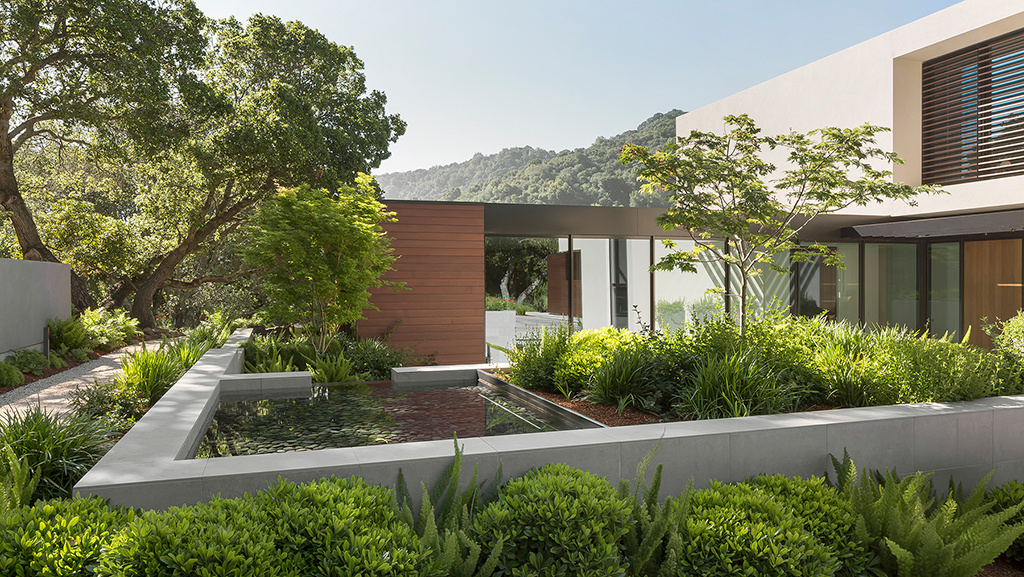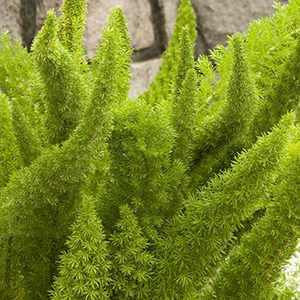Creating an upscale personal retreat that feels lush and uses water wisely might sound like a project with objectives at odds with one another. However, with a little waterwise planning and the right plants, it is possible. The San Francisco-based landscape architecture firm Arterra designed just such a space, the Slot House, in Los Altos Hills, California.
The Slot House's environs, which consisted of native oak woodlands, presented a luxurious natural backdrop, but it also dictated a landscape that would play well with its need for dry conditions. What Arterra developed was a setting that used ornamentals, Mediterranean-like species, and native plants that would blend into the natural woodlands in a waterwise setting.
Join us as we learn to implement smart, beautiful, and waterwise design choices in our gardens by using the Slot House as a learning ground. Arterra’s Founding Partner Kate Stickley brings us her top waterwise design lessons on this tour through the fabulous drought-tolerant retreat.
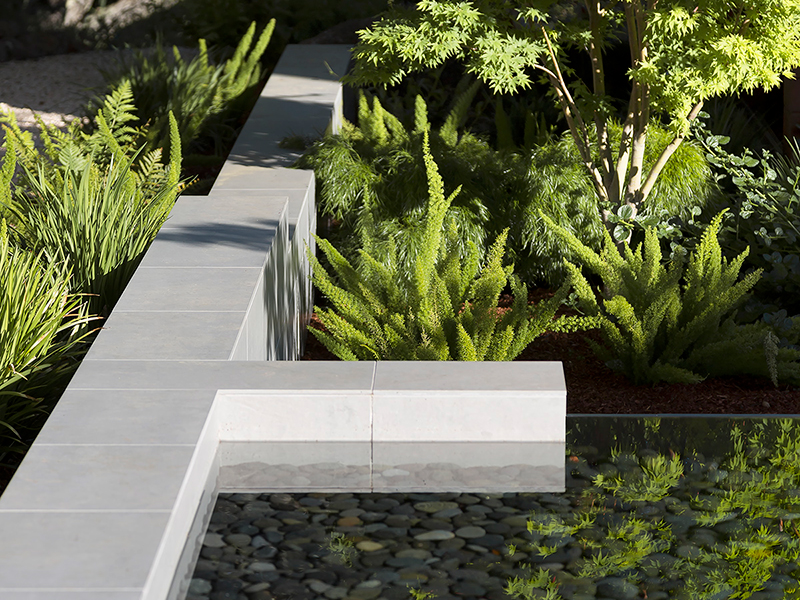
(Above) Even deserts have oases. A drought-tolerant garden can indeed have a water feature. This cascading water feature recirculates for several stories, providing white noise for the property as well as being a home for several plants with moderate water needs such as (clockwise for lower center) Asparagus densiflorus ‘Myers’, Ceanothus griseus var. horizontalis, Acasia ‘Cousin Itt’, Woodwardia fimbriata and Liriope muscari.
Top 3 Waterwise Landscape Lessons
1. Create Zones
Arterra created three landscaped zones for the Slot House, each with a different category of moisture needs:
- The living roof, a drought-tolerant garden viewed from the residence’s second floor, is completely composed of succulents. The succulents’ fiery colors and structural components look like a watery coral reef. Set against the monochromatic greens of the coastal ridges in the distance, the garden’s color range—from its pale greens to reddish greens—glows even more intensely.
- Surrounding the residence, Arterra underplanted the transition zone with a palette of plants such as native ferns, flowering currant, coffeeberry, and other plants that are adapted to this particular microclimate. The planted landscape here was designed to coexist with the wet winter/dry summer native environment.
- Arterra placed ornamental plantings with moderate moisture needs closer to the home. Here they include more Mediterranean-style plantings, activating the space with both plant color and texture.
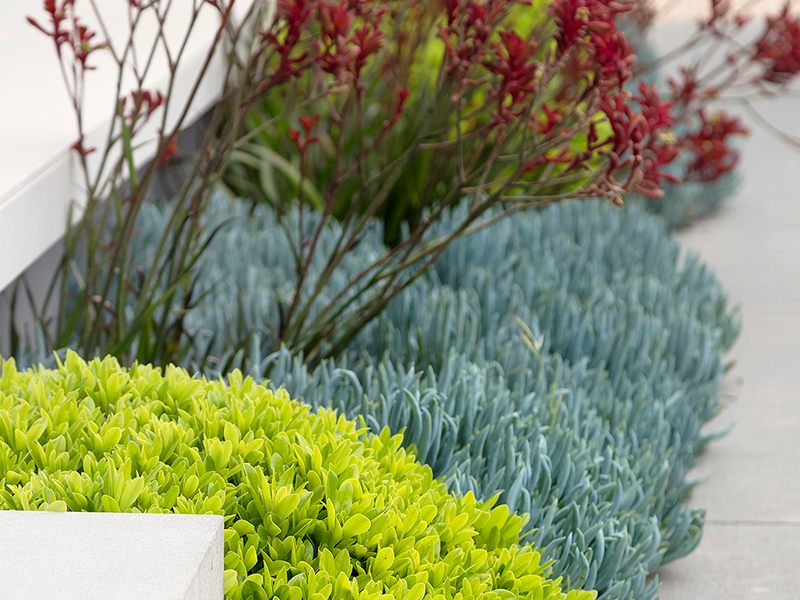
(Above) The Slot House’s ornamental plantings serve as two examples of upscale waterwise design: 1) Low- to moderate-water-use plants such as these Pittosporum tobira ‘Wheeler’s Dwarf’, Senecio mandraliscae, and Anigozanthos ‘Bush Blaze’ are clustered close to the residence for easier irrigation. 2) Minimizing the plant palette yet using it consistently helps to tie the landscape together around the entire residence.
2. Aging Well with Less Water
Using moderate water use and ornamental plantings is not contrary to establishing a drought-tolerant garden. Arterra has found that plantings such as these will acclimate over a few years to tolerate drier conditions. For instance, Foxtail Fern (Asparagus densiflorus) ‘Meyers’ and Wheeler’s Dwarf Japanese Pittosporum (Pittosporum tobira) would not be considered drought-tolerant plants, but, over time, won’t need a lot of water.
Kate’s Waterwise Lesson:
“Sometimes, we choose plants that may not be technically drought tolerant but are on the low-water side. Over time, we can dial back the irrigation once the plants are established and keep an eye on the amount of water they're using.”
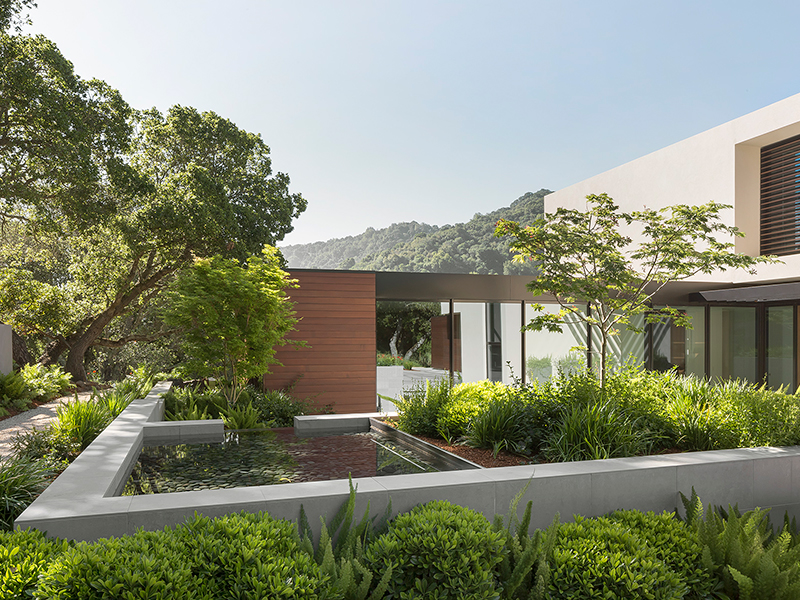
(Above) A waterwise landscape planting need not be a drought-tolerant planting from the get go. With time and an eye on dialing back the irrigation each year, plantings of moderate water use plants such as (from the far left) Woodwardia fimbriata, Acer palmatum ‘Sango Kaku’, Ceanothus grieus var. horizontalis, Liriope muscari, Acer japonicum ‘Aconitifolium’, Asparagus densiflorus ‘Myers’ and Pittosporum tobira ‘Wheeler’s Dwarf’ can thrive with lower water inputs.
3. Future-Proof Your Garden
It’s not enough to consider what plants grow in your current USDA Plant Hardiness Zone. Due to the warming climate, Arterra has begun to utilize plants from one to two zones south so that in a few years, those plants will be able to handle warmer and drier conditions than what they are currently experiencing.
Kate’s Waterwise Lesson:
"Future-proofing your current landscape is a smart way to ensure your gardens survive in years to come."
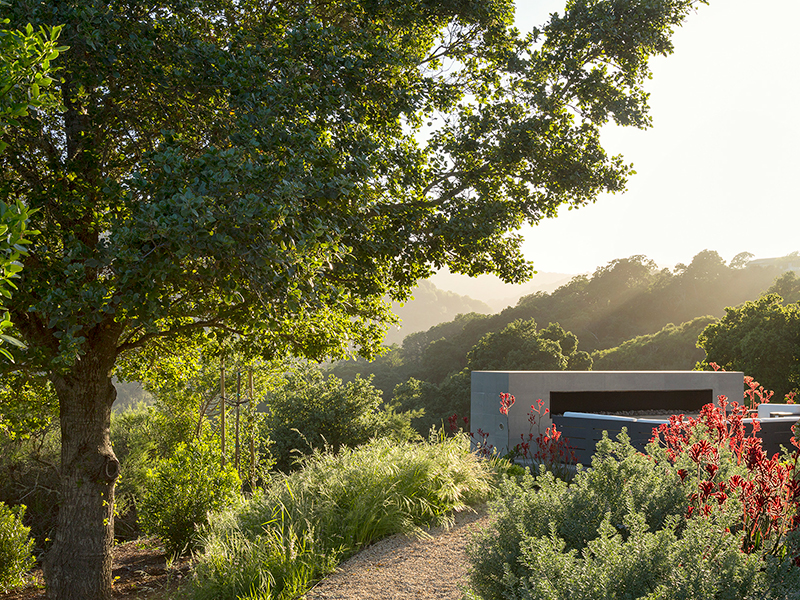
(Above) The Slot House is set amidst a native oak (Quercus agrifolia) woodland with a native fescue grass mix. Arterra took care to integrate the created landscape with this native woodland, specifying low-to-moderate water use plants along the residence’s perimeter, including Pacific Wax Myrtle (Myrica californica), Coast Rosemary (Westringia fruticosa) and Kangaroo Paw (Anigozanthos ‘Bush Blaze’).
Top 3 Design Lessons
1. Use Plant Color and Texture to Activate an Upscale Design
Much of today’s upscale architecture can have a stark appearance. Landscape plantings both soften and enliven structures that could otherwise seem austere. The Arterra team intentionally used plantings to add color and texture to a predominantly off-white structure.
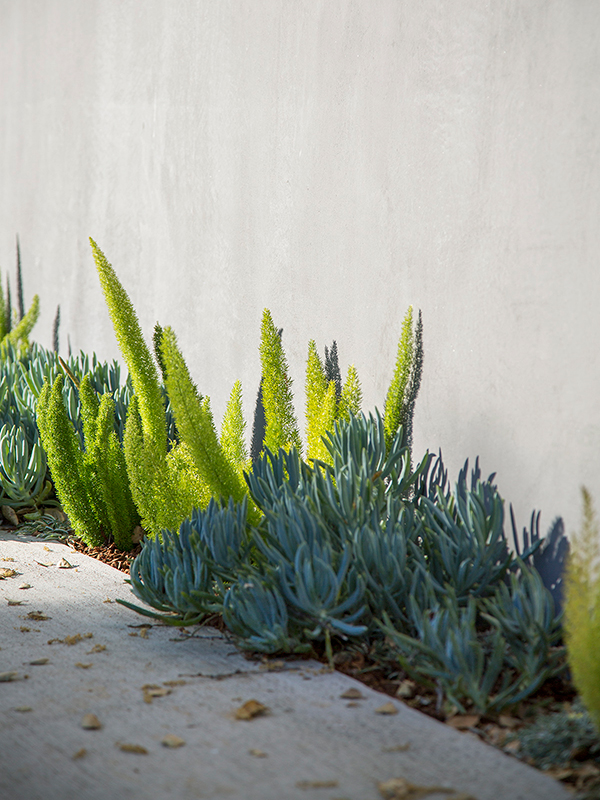
(Above) Foxtail Fern (Asparagus densiflorus ‘Myers’) and Senecio mandraliscae provide just a few hues of green in the Slot House’s overall landscape. Using shades and textures of the same color activates the plantings and makes the landscape pop.
Even a monochromatic color scheme can pop. The Arterra team chose plants with interesting foliage that makes the shades of green visually intriguing. Red Kanagaroo Paw was chosen as a drought-tolerant splash of color, which complements the red structural components of the residence. The result is a consistently lush and interesting composition that isn't dependent on fall color and spring flowering.
Kate’s Design Lesson:
“The architecture, while striking and dramatic, is pretty simple from a color standpoint, so we decided that the landscape and the planting would carry that complement.”
2. Less Is More
In a time when maximalism’s “more is more” model is trending in interior and exterior designs, an upscale aesthetic calls for adherence to an unassuming style. To this end, a consistent pattern of a limited palette of foliage plants surrounds the residence.
Kate’s Design Lesson:
“In contemporary gardens, where less is more, a simple approach supports the architecture a little more solidly than if there's a lot of variation.”
3. Splashes of the Unexpected
As a pinch of salt enhances the flavors of a sweet dessert, a splash of unexpected color can activate the repetition of a limited plant palette. The color red is seen within the Slot House’s outdoor structure sparingly—in a waterfall element and in the patio, for instance. Arterra repeats this splash of red using Bush Ballad Kanagroo Paw, which flowers from spring through fall.
Kate’s Design Lesson:
“The red is used where it can be an unexpected surprise.”
For inspiration and ideas to create waterwise gardens in different styles, be sure to read “Modern Cottage Design: A Waterwise, Low-Maintenance Front Yard.”
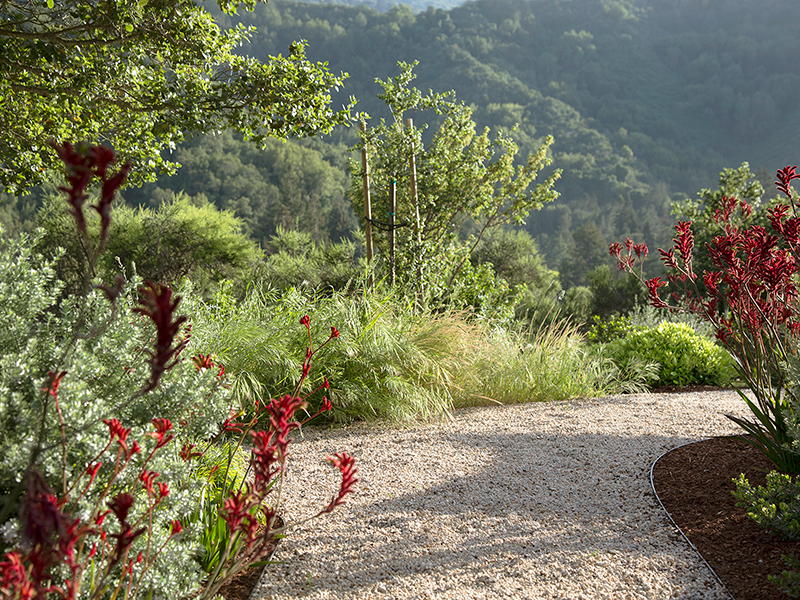
(Above) In a native-adjacent landscape dominated by greens, pops of color help to relieve the eye. Here, Anigozanthos ‘Bush Blaze’ adds that splash of unexpected red that activates the created landscape.
Non-Plant Takeaways
Other elements that add to the aesthetic of an upscale water-wise garden retreat include:
Water: A small fountain or waterfall offers a meditative auditory experience while providing a cooling effect.
Stone: The variety of stone sizes, colors, textures, and shapes is a design element in its own right.
Lighting: Playing off the textures of a garden, lighting extends the feel of the space when its dark.
Hear it From the Experts
Gardening with an eye toward using water wisely can be intimidating. Monrovia’s Katie Tamony and Georgia Clay made the topic more accessible and less stress-inducing during a Waterwise Gardening Webinar. The pair offered suggestions for low-water landscape designs, efficient watering techniques, and smart (and beautiful!) plant choices. Whether you are in a drought-prone region or just want to use less water, this discussion will present ideas and inspiration to get you on your way.
Get the Look with these Waterwise Plants
For additional waterwise and drought-tolerant perennials for a range of Zones, be sure to read “Favorite Bold and Beautiful Drought-Tolerant Plants.”
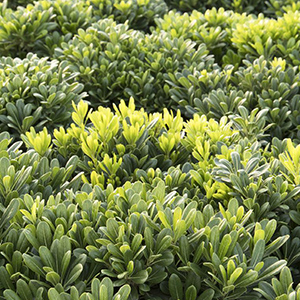
Wheeler’s Dwarf
Japanese Pittosporum
While not a drought-tolerant plant per se, this Pittosporum can become a waterwise garden star with decreasing irrigation over time once it is established. Part to full sun. Up to 3’ tall and 5’ wide. Zones 8-11.
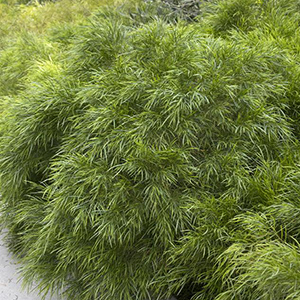
Cousin Itt
Acasia
This texturally stunning small shrub thrives in hot inland or coastal settings, needing little water or care once established. Excelling in Mediterranean-style landscapes, ‘Cousin Itt’ can be used in hillside plantings, rock gardens and as focal plants in larger containers. Part to full sun. Up to 3’ tall and 6’ wide. Zones 9-11.
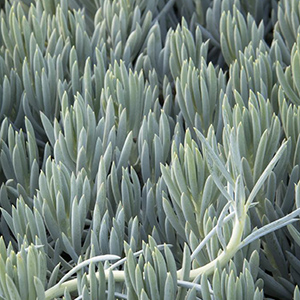
Blue Finger
Senecio
The striking blue-gray and slightly curved leaves of Blue Finger Senecio form a dense and drought-tolerant groundcover. Can also be used as a textural element in mixed containers. Full sun. Up to 2’ tall and 3’ wide. Zones 10-11.
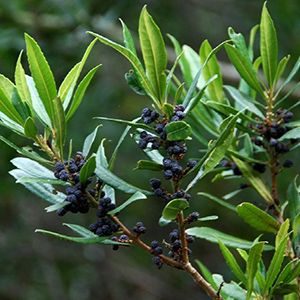
Pacific Wax
Myrytle
This native shrub needs little-to-no water or care once it’s established in the landscape. Use as a windbreak, screen, or hedge. Full sun. Up to 20-30’ tall and 10-20’ wide. Zones 7-9.
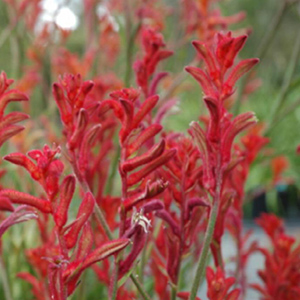
Bush Ballad
Kangaroo Paw
Add a pop or a mass of color to your drought-tolerant plants with these red blooms set atop elongated stalks. Full sun. Flower stalks grow up to 2’ tall. Zones 10-11.
About the Designer
Kate Stickley's journey into landscape architecture began with clearing trails in the Brandywine River Valley. After earning her degree from Michigan State University, she specialized in large-scale resort design across the Southeastern United States and Caribbean. She then spent four transformative years in Provence, where her passion for Mediterranean plants and sustainable landscaping blossomed.

Kate brings a deep appreciation for craftsmanship from her collaborations with artisans in Europe to her work at Arterra, emphasizing exceptional detailing and design. She holds memberships in the American Society of Landscape Architects, The Association of Professional Landscape Designers, Build It Green, and the National Association of Women Business Owners. Recognized as a Certified Green Building Professional, she integrates sustainable practices into every garden project.
Explore More Drought-Tolerant Resources and Plants
- Modern Cottage Design: A Waterwise, Low-Maintenance Front Yard
- Lawn to Waterwise Landscape Transformation: Xeriscape Design that's Lush and Vibrant
- Mediterranean Garden Design Inspiration from the Experts
- Favorite Drought-Tolerant Plants
- Low Water, High Beauty Waterwise Gardening Digital Guide
- Favorite Drought-Tolerant Edible Plants
- U.S. Drought Monitor
- Container Plants for Full Sun and Heat
- Heat-Tolerant Plants: Cool shades for hot gardens
- Sculptural Succulents for Warm and Temperate Climates
- Dry-Farmed Gardens
- 6 Easy Ways to Save Water In The Garden
- Summer Watering Tips
- Hot Season Heroes
- Cool Combo: White and Waterwise
- What's THAT: Aloe




